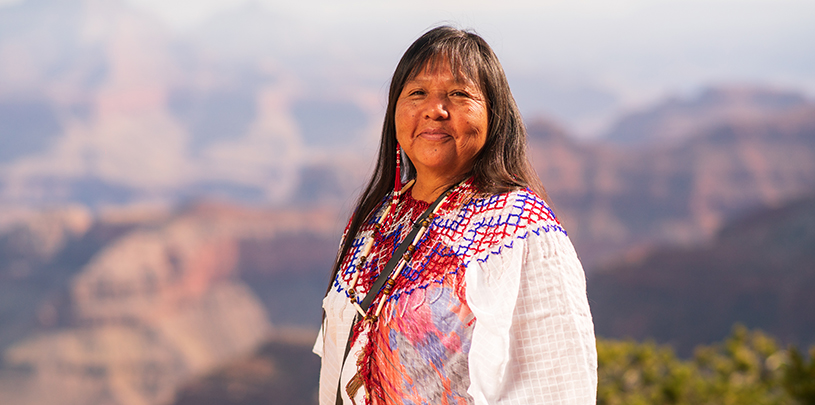
 by Sarana Riggs, Grand Canyon Manager
by Sarana Riggs, Grand Canyon Manager
Coleen Kaska, a former Havasupai tribal council woman, stands on the rim of the Grand Canyon, looking into the abyss she and her ancestors have called home since time immemorial. Red and blue ribbons embellish her white dress; a beaded cape drapes across her shoulders. Havasupai regalia, Kaska says, used to be made of deer hide instead of the cotton she’s wearing today. “But we adapt to the situations and the future, whatever it brings. My people have learned to adapt — that’s why we’re still here,” she adds.
Below, Kaska gives us a glimpse of how the Havasupai have adapted since their homelands were declared Grand Canyon National Park a century ago.
The Havasupai people right now reside on the reservation in Supai Village, which is 50 miles west of the south rim of Grand Canyon National Park. But this whole area is aboriginal territory for the Havasupai people, my people, Havasu ‘Baaja, which means “people of the blue green waters.” This whole area belonged to them, my ancestors. They roamed this whole area. My tribe has lost over 500 million acres, which includes all the plateau lands up here and Grand Canyon National Park. We’re told that we could not live down there anymore.
When you are hiking into our village, you will not see any water source. There’s hardly any shade, and it seems like the trail just keeps going for ever. I even think to myself, ‘what were my people thinking when they were hiking down this trail?’
My heart is just happy when I go down that trail to this day. I’m just thankful my ancestors didn’t give up because, once they got down to the bottom, what do you see? You smell all the vegetation…you smell the water…you smell all those native trees, the willow trees in the village. You smell all that fresh air, and you see the river right by you, and it’s just beautiful. You keep walking further, and you come to the village of Supai where the residents live. You go another 2 miles or so and you come to the waterfalls. That’s what people go down to the village of Supai to see — the waterfalls.
 ED MOSS
ED MOSS
Water is everything for my people. We use it for every little thing. Cooking, drinking, washing clothes, for our animals. And then farming as well. For our crops during the summer time.
The water does not say ‘I belong to you.’ The water does not say 'I’m going to go this way for these people over here.' The water has its own source, its own running way, its own nature. That’s just the way nature runs. It does not belong to anybody, it belongs to everybody.
For over 100 years for my people, we’ve lost a lot of mingling and just coming up here enjoying the scenery, picking herbs, and living like my ancestors used to. But my parents have always told me about this area when I was growing up in the village of Supai. They would describe landmarks like Red Butte and Indian Gardens. But being young and restricted to the reservation, it was just oral stories that were given to us. I think my people as a tribe should be really thankful that they didn’t forget this area. They always pushed it to tell us stories and keep letting us know that it’s been taken away from us. ‘You as a youngster, you need to grow up and pursue the lands that we have lost,’ is what I was taught from my mom and dad.
Red Butte is our place of emergence. When the world was flooded with so much water, they put this little girl in a canoe or boat where she floated for days. She landed at the San Francisco Peaks (Wii Hagnbaja), and then she found her way to our place of emergence at the top of Red Butte. So that is our place of emergence. To this day, it is said that her boat is petrified and still remains on Wii Hagnbaja.
The Red Butte area right now is in the danger zone for my people because of the river that runs through our village. We have been told the water comes from up here on the plateau areas. You cannot see it, it’s all underground, but it reaches our village. And the Red Butte area is open to uranium mining with the Energy Fuels Nuclear, who has a permit to operate 5 miles north of our emergence place.
Know that Natives are still around, it’s just they’ve been restricted from the area of their roaming grounds. But they are still in the region. And they will never forget. I will never forget.
80% of Arizona voters support Baaj Nwaavjo I'tah Kukveni National Monument, according to a new poll.
Read MoreUtah voters strongly support national monuments in general, and Bears Ears and Grand Staircase-Escalante in particular, a new poll shows.
Read MoreA small victory in the legal case challenging Daneros uranium mine, near Bears Ears National Monument.
Read More